Multinational Mining Corporation Expansion: An Investment Evaluation
VerifiedAdded on 2023/06/01
|13
|4199
|469
Report
AI Summary
This report provides an in-depth evaluation of a multinational mining corporation's proposed business expansion, considering risks, costs, and potential benefits. It examines various methodologies for evaluating the investment, including payback period, net present value, internal rate of return, and benefit-cost ratio. The report also explores available financing opportunities, such as government subsidies, equity, and private financial agreements. Furthermore, it discusses the process of setting financial and non-financial performance targets and reporting on performance. The report concludes with a recommendation for the mining corporation to proceed with its expansion plan, emphasizing strategies to minimize employee turnover and create a positive working environment to attract new employees.

GLOBAL BUSINESS ASSIGNMENT 1
Global Business Economics and Finance
Name
Student ID
Course
Institutional Affiliation
Global Business Economics and Finance
Name
Student ID
Course
Institutional Affiliation
Paraphrase This Document
Need a fresh take? Get an instant paraphrase of this document with our AI Paraphraser
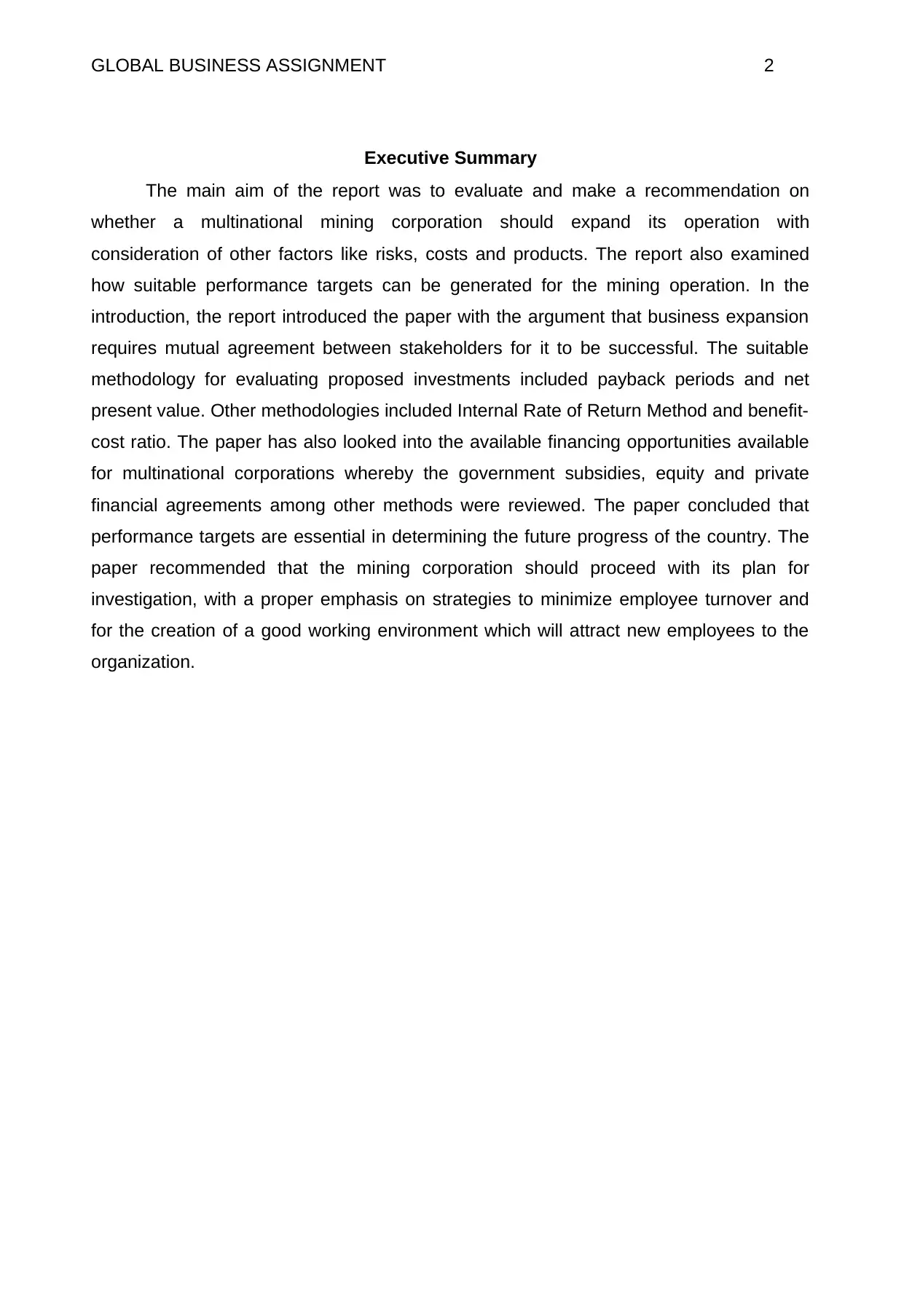
GLOBAL BUSINESS ASSIGNMENT 2
Executive Summary
The main aim of the report was to evaluate and make a recommendation on
whether a multinational mining corporation should expand its operation with
consideration of other factors like risks, costs and products. The report also examined
how suitable performance targets can be generated for the mining operation. In the
introduction, the report introduced the paper with the argument that business expansion
requires mutual agreement between stakeholders for it to be successful. The suitable
methodology for evaluating proposed investments included payback periods and net
present value. Other methodologies included Internal Rate of Return Method and benefit-
cost ratio. The paper has also looked into the available financing opportunities available
for multinational corporations whereby the government subsidies, equity and private
financial agreements among other methods were reviewed. The paper concluded that
performance targets are essential in determining the future progress of the country. The
paper recommended that the mining corporation should proceed with its plan for
investigation, with a proper emphasis on strategies to minimize employee turnover and
for the creation of a good working environment which will attract new employees to the
organization.
Executive Summary
The main aim of the report was to evaluate and make a recommendation on
whether a multinational mining corporation should expand its operation with
consideration of other factors like risks, costs and products. The report also examined
how suitable performance targets can be generated for the mining operation. In the
introduction, the report introduced the paper with the argument that business expansion
requires mutual agreement between stakeholders for it to be successful. The suitable
methodology for evaluating proposed investments included payback periods and net
present value. Other methodologies included Internal Rate of Return Method and benefit-
cost ratio. The paper has also looked into the available financing opportunities available
for multinational corporations whereby the government subsidies, equity and private
financial agreements among other methods were reviewed. The paper concluded that
performance targets are essential in determining the future progress of the country. The
paper recommended that the mining corporation should proceed with its plan for
investigation, with a proper emphasis on strategies to minimize employee turnover and
for the creation of a good working environment which will attract new employees to the
organization.
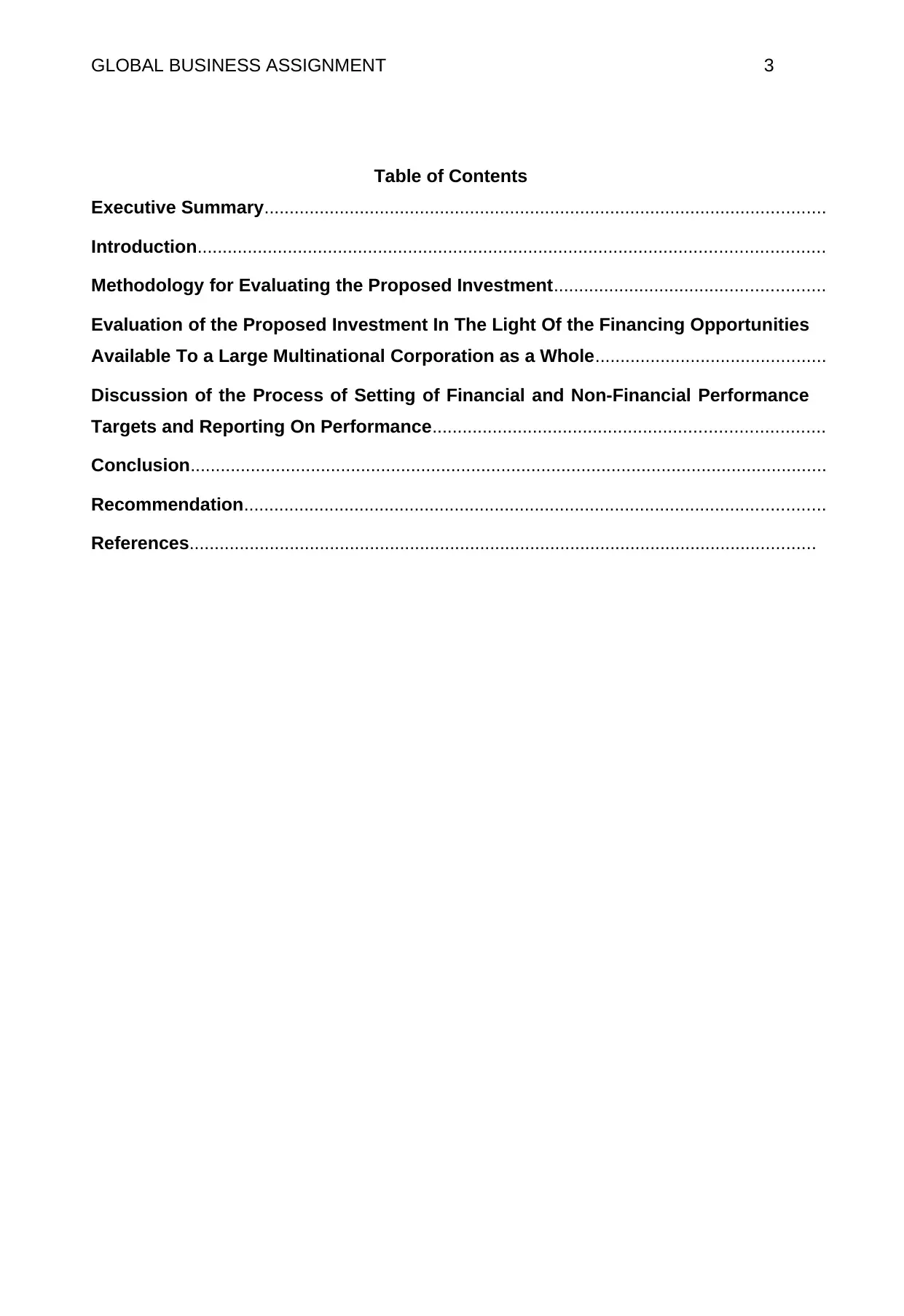
GLOBAL BUSINESS ASSIGNMENT 3
Table of Contents
Executive Summary................................................................................................................
Introduction.............................................................................................................................
Methodology for Evaluating the Proposed Investment......................................................
Evaluation of the Proposed Investment In The Light Of the Financing Opportunities
Available To a Large Multinational Corporation as a Whole..............................................
Discussion of the Process of Setting of Financial and Non-Financial Performance
Targets and Reporting On Performance..............................................................................
Conclusion...............................................................................................................................
Recommendation....................................................................................................................
References.............................................................................................................................
Table of Contents
Executive Summary................................................................................................................
Introduction.............................................................................................................................
Methodology for Evaluating the Proposed Investment......................................................
Evaluation of the Proposed Investment In The Light Of the Financing Opportunities
Available To a Large Multinational Corporation as a Whole..............................................
Discussion of the Process of Setting of Financial and Non-Financial Performance
Targets and Reporting On Performance..............................................................................
Conclusion...............................................................................................................................
Recommendation....................................................................................................................
References.............................................................................................................................
⊘ This is a preview!⊘
Do you want full access?
Subscribe today to unlock all pages.

Trusted by 1+ million students worldwide
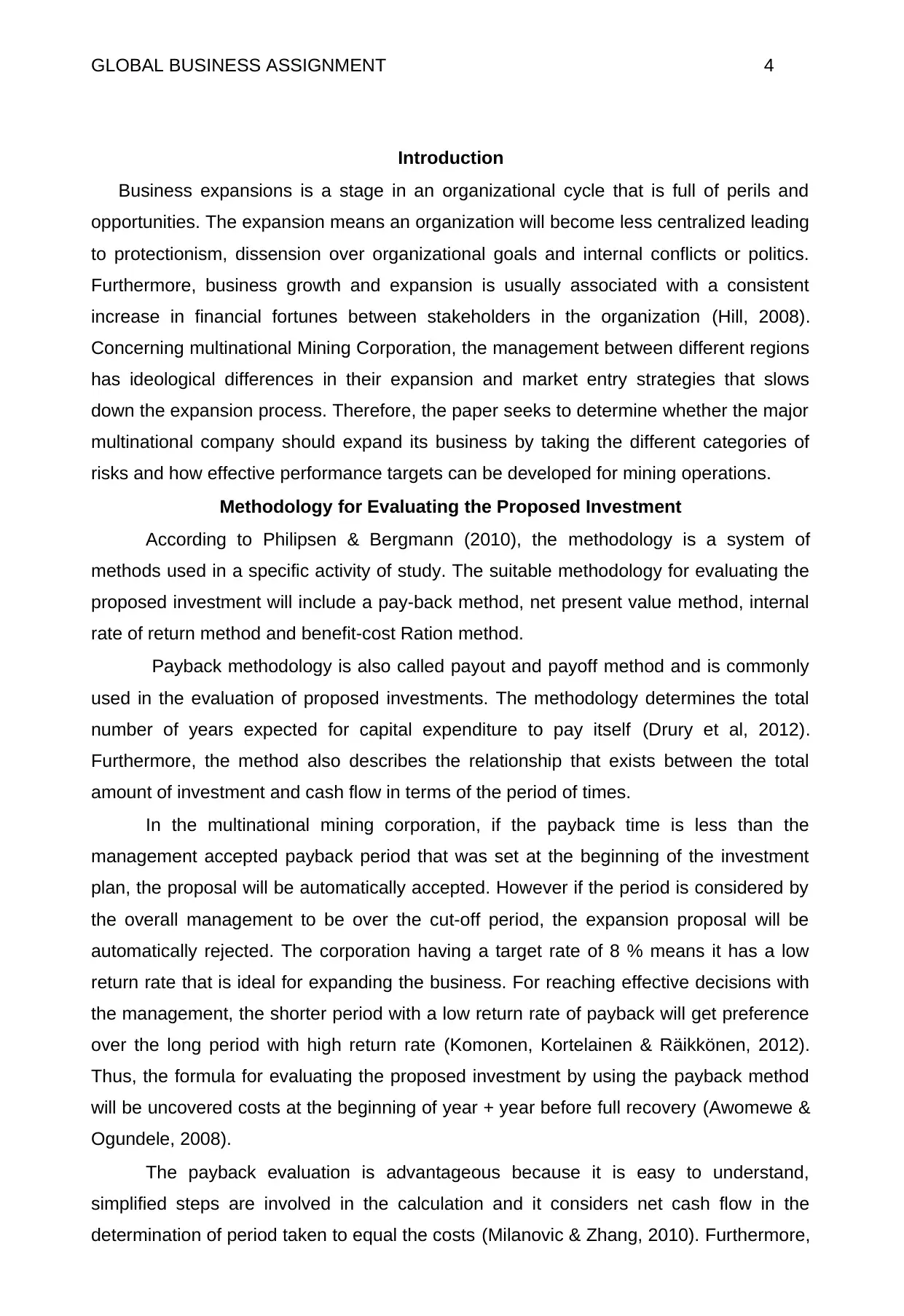
GLOBAL BUSINESS ASSIGNMENT 4
Introduction
Business expansions is a stage in an organizational cycle that is full of perils and
opportunities. The expansion means an organization will become less centralized leading
to protectionism, dissension over organizational goals and internal conflicts or politics.
Furthermore, business growth and expansion is usually associated with a consistent
increase in financial fortunes between stakeholders in the organization (Hill, 2008).
Concerning multinational Mining Corporation, the management between different regions
has ideological differences in their expansion and market entry strategies that slows
down the expansion process. Therefore, the paper seeks to determine whether the major
multinational company should expand its business by taking the different categories of
risks and how effective performance targets can be developed for mining operations.
Methodology for Evaluating the Proposed Investment
According to Philipsen & Bergmann (2010), the methodology is a system of
methods used in a specific activity of study. The suitable methodology for evaluating the
proposed investment will include a pay-back method, net present value method, internal
rate of return method and benefit-cost Ration method.
Payback methodology is also called payout and payoff method and is commonly
used in the evaluation of proposed investments. The methodology determines the total
number of years expected for capital expenditure to pay itself (Drury et al, 2012).
Furthermore, the method also describes the relationship that exists between the total
amount of investment and cash flow in terms of the period of times.
In the multinational mining corporation, if the payback time is less than the
management accepted payback period that was set at the beginning of the investment
plan, the proposal will be automatically accepted. However if the period is considered by
the overall management to be over the cut-off period, the expansion proposal will be
automatically rejected. The corporation having a target rate of 8 % means it has a low
return rate that is ideal for expanding the business. For reaching effective decisions with
the management, the shorter period with a low return rate of payback will get preference
over the long period with high return rate (Komonen, Kortelainen & Räikkönen, 2012).
Thus, the formula for evaluating the proposed investment by using the payback method
will be uncovered costs at the beginning of year + year before full recovery (Awomewe &
Ogundele, 2008).
The payback evaluation is advantageous because it is easy to understand,
simplified steps are involved in the calculation and it considers net cash flow in the
determination of period taken to equal the costs (Milanovic & Zhang, 2010). Furthermore,
Introduction
Business expansions is a stage in an organizational cycle that is full of perils and
opportunities. The expansion means an organization will become less centralized leading
to protectionism, dissension over organizational goals and internal conflicts or politics.
Furthermore, business growth and expansion is usually associated with a consistent
increase in financial fortunes between stakeholders in the organization (Hill, 2008).
Concerning multinational Mining Corporation, the management between different regions
has ideological differences in their expansion and market entry strategies that slows
down the expansion process. Therefore, the paper seeks to determine whether the major
multinational company should expand its business by taking the different categories of
risks and how effective performance targets can be developed for mining operations.
Methodology for Evaluating the Proposed Investment
According to Philipsen & Bergmann (2010), the methodology is a system of
methods used in a specific activity of study. The suitable methodology for evaluating the
proposed investment will include a pay-back method, net present value method, internal
rate of return method and benefit-cost Ration method.
Payback methodology is also called payout and payoff method and is commonly
used in the evaluation of proposed investments. The methodology determines the total
number of years expected for capital expenditure to pay itself (Drury et al, 2012).
Furthermore, the method also describes the relationship that exists between the total
amount of investment and cash flow in terms of the period of times.
In the multinational mining corporation, if the payback time is less than the
management accepted payback period that was set at the beginning of the investment
plan, the proposal will be automatically accepted. However if the period is considered by
the overall management to be over the cut-off period, the expansion proposal will be
automatically rejected. The corporation having a target rate of 8 % means it has a low
return rate that is ideal for expanding the business. For reaching effective decisions with
the management, the shorter period with a low return rate of payback will get preference
over the long period with high return rate (Komonen, Kortelainen & Räikkönen, 2012).
Thus, the formula for evaluating the proposed investment by using the payback method
will be uncovered costs at the beginning of year + year before full recovery (Awomewe &
Ogundele, 2008).
The payback evaluation is advantageous because it is easy to understand,
simplified steps are involved in the calculation and it considers net cash flow in the
determination of period taken to equal the costs (Milanovic & Zhang, 2010). Furthermore,
Paraphrase This Document
Need a fresh take? Get an instant paraphrase of this document with our AI Paraphraser

GLOBAL BUSINESS ASSIGNMENT 5
the method is adjustable for late cash flow uncertainty. However; the method will fail to
consider the cash flow of the mining corporate after the payback period and therefore it
will result in inaccurate profits. Importantly, the method ignores the time value for money
and financing costs of investment that can be essential in assessing the corporate project
productivity (Sakthivel, Bhuvaneswari & Subramanian, 2010).
Net present value (NPV) is used in proposal evaluation to determine the difference
between the total present value of future cash inflows and the total present value of
future cash outflows (Hsieh, Dye & Ouyang, 2008). NPV determines the worthiness of
the project in terms of the current value of money. If the net present value is zero, then
the cash flow for the mining expansion project will be capable of repaying the funds
investment and provision of desired Return rate on capital. Thus, the method for
evaluating NPV is the present value of future net cash flows (PV) minus Initial
investments (IO) (Chen, Li & Reynolds, 2012). If the cash flow is equal or greater than
zero, the expansion plan is acceptable and if is less than zero the project becomes
rejected automatically by management. Other minor methodologies for evaluating
proposals include Internal Rate of Return Method that measures return rates which
earnings are expected to yield on investment (Magni, 2010) and Benefit-cost ratio
benefits that are used in summarization of overall value of money for the proposal.
Evaluation of the Proposed Investment In The Light Of the Financing Opportunities
Available To a Large Multinational Corporation as a Whole
According to Taylor and Thrift (2012) multinational corporations can find themselves
trapped in a demand for cash in today’s volatile business climate. The mining firm needs
cash to expand its operations, and although it is facing pressure from the directors in
regards to the low income and staff turnover, expanding the business may just be the
best idea. The new coal mines may bring good income to the firm which would subsidize
the current revenue. If a multinational corporation needs operating cash or cash for
expansion, the funds can be raised through various methods from private loans to share
issues (Manova, Wei & Zhang, 2015). The sources of funding for multinational
corporations include equity, government subsidies and private financing agreements.
The coal mining firm so as to acquire enough funds for expansion could issue equity in
exchange for cash, whereby investment banks will solve the firm’s financial issues.
Multinational companies can also get funding by selling debt products (Alexander, Mazza
& Scholz, 2009). Therefore, the mining firm can raise funds for expansion through the
selling of debt in form of bonds.
the method is adjustable for late cash flow uncertainty. However; the method will fail to
consider the cash flow of the mining corporate after the payback period and therefore it
will result in inaccurate profits. Importantly, the method ignores the time value for money
and financing costs of investment that can be essential in assessing the corporate project
productivity (Sakthivel, Bhuvaneswari & Subramanian, 2010).
Net present value (NPV) is used in proposal evaluation to determine the difference
between the total present value of future cash inflows and the total present value of
future cash outflows (Hsieh, Dye & Ouyang, 2008). NPV determines the worthiness of
the project in terms of the current value of money. If the net present value is zero, then
the cash flow for the mining expansion project will be capable of repaying the funds
investment and provision of desired Return rate on capital. Thus, the method for
evaluating NPV is the present value of future net cash flows (PV) minus Initial
investments (IO) (Chen, Li & Reynolds, 2012). If the cash flow is equal or greater than
zero, the expansion plan is acceptable and if is less than zero the project becomes
rejected automatically by management. Other minor methodologies for evaluating
proposals include Internal Rate of Return Method that measures return rates which
earnings are expected to yield on investment (Magni, 2010) and Benefit-cost ratio
benefits that are used in summarization of overall value of money for the proposal.
Evaluation of the Proposed Investment In The Light Of the Financing Opportunities
Available To a Large Multinational Corporation as a Whole
According to Taylor and Thrift (2012) multinational corporations can find themselves
trapped in a demand for cash in today’s volatile business climate. The mining firm needs
cash to expand its operations, and although it is facing pressure from the directors in
regards to the low income and staff turnover, expanding the business may just be the
best idea. The new coal mines may bring good income to the firm which would subsidize
the current revenue. If a multinational corporation needs operating cash or cash for
expansion, the funds can be raised through various methods from private loans to share
issues (Manova, Wei & Zhang, 2015). The sources of funding for multinational
corporations include equity, government subsidies and private financing agreements.
The coal mining firm so as to acquire enough funds for expansion could issue equity in
exchange for cash, whereby investment banks will solve the firm’s financial issues.
Multinational companies can also get funding by selling debt products (Alexander, Mazza
& Scholz, 2009). Therefore, the mining firm can raise funds for expansion through the
selling of debt in form of bonds.
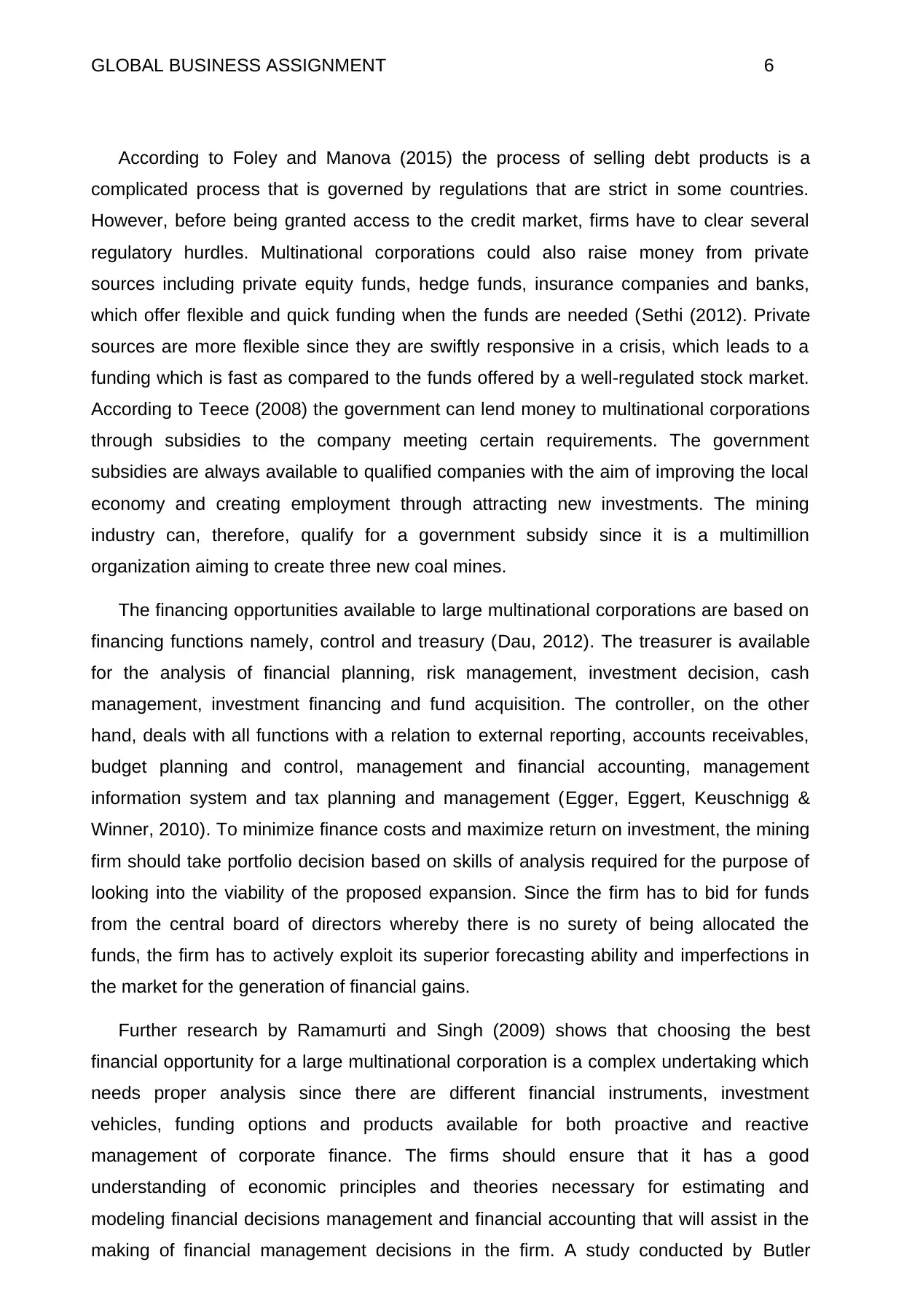
GLOBAL BUSINESS ASSIGNMENT 6
According to Foley and Manova (2015) the process of selling debt products is a
complicated process that is governed by regulations that are strict in some countries.
However, before being granted access to the credit market, firms have to clear several
regulatory hurdles. Multinational corporations could also raise money from private
sources including private equity funds, hedge funds, insurance companies and banks,
which offer flexible and quick funding when the funds are needed (Sethi (2012). Private
sources are more flexible since they are swiftly responsive in a crisis, which leads to a
funding which is fast as compared to the funds offered by a well-regulated stock market.
According to Teece (2008) the government can lend money to multinational corporations
through subsidies to the company meeting certain requirements. The government
subsidies are always available to qualified companies with the aim of improving the local
economy and creating employment through attracting new investments. The mining
industry can, therefore, qualify for a government subsidy since it is a multimillion
organization aiming to create three new coal mines.
The financing opportunities available to large multinational corporations are based on
financing functions namely, control and treasury (Dau, 2012). The treasurer is available
for the analysis of financial planning, risk management, investment decision, cash
management, investment financing and fund acquisition. The controller, on the other
hand, deals with all functions with a relation to external reporting, accounts receivables,
budget planning and control, management and financial accounting, management
information system and tax planning and management (Egger, Eggert, Keuschnigg &
Winner, 2010). To minimize finance costs and maximize return on investment, the mining
firm should take portfolio decision based on skills of analysis required for the purpose of
looking into the viability of the proposed expansion. Since the firm has to bid for funds
from the central board of directors whereby there is no surety of being allocated the
funds, the firm has to actively exploit its superior forecasting ability and imperfections in
the market for the generation of financial gains.
Further research by Ramamurti and Singh (2009) shows that choosing the best
financial opportunity for a large multinational corporation is a complex undertaking which
needs proper analysis since there are different financial instruments, investment
vehicles, funding options and products available for both proactive and reactive
management of corporate finance. The firms should ensure that it has a good
understanding of economic principles and theories necessary for estimating and
modeling financial decisions management and financial accounting that will assist in the
making of financial management decisions in the firm. A study conducted by Butler
According to Foley and Manova (2015) the process of selling debt products is a
complicated process that is governed by regulations that are strict in some countries.
However, before being granted access to the credit market, firms have to clear several
regulatory hurdles. Multinational corporations could also raise money from private
sources including private equity funds, hedge funds, insurance companies and banks,
which offer flexible and quick funding when the funds are needed (Sethi (2012). Private
sources are more flexible since they are swiftly responsive in a crisis, which leads to a
funding which is fast as compared to the funds offered by a well-regulated stock market.
According to Teece (2008) the government can lend money to multinational corporations
through subsidies to the company meeting certain requirements. The government
subsidies are always available to qualified companies with the aim of improving the local
economy and creating employment through attracting new investments. The mining
industry can, therefore, qualify for a government subsidy since it is a multimillion
organization aiming to create three new coal mines.
The financing opportunities available to large multinational corporations are based on
financing functions namely, control and treasury (Dau, 2012). The treasurer is available
for the analysis of financial planning, risk management, investment decision, cash
management, investment financing and fund acquisition. The controller, on the other
hand, deals with all functions with a relation to external reporting, accounts receivables,
budget planning and control, management and financial accounting, management
information system and tax planning and management (Egger, Eggert, Keuschnigg &
Winner, 2010). To minimize finance costs and maximize return on investment, the mining
firm should take portfolio decision based on skills of analysis required for the purpose of
looking into the viability of the proposed expansion. Since the firm has to bid for funds
from the central board of directors whereby there is no surety of being allocated the
funds, the firm has to actively exploit its superior forecasting ability and imperfections in
the market for the generation of financial gains.
Further research by Ramamurti and Singh (2009) shows that choosing the best
financial opportunity for a large multinational corporation is a complex undertaking which
needs proper analysis since there are different financial instruments, investment
vehicles, funding options and products available for both proactive and reactive
management of corporate finance. The firms should ensure that it has a good
understanding of economic principles and theories necessary for estimating and
modeling financial decisions management and financial accounting that will assist in the
making of financial management decisions in the firm. A study conducted by Butler
⊘ This is a preview!⊘
Do you want full access?
Subscribe today to unlock all pages.

Trusted by 1+ million students worldwide
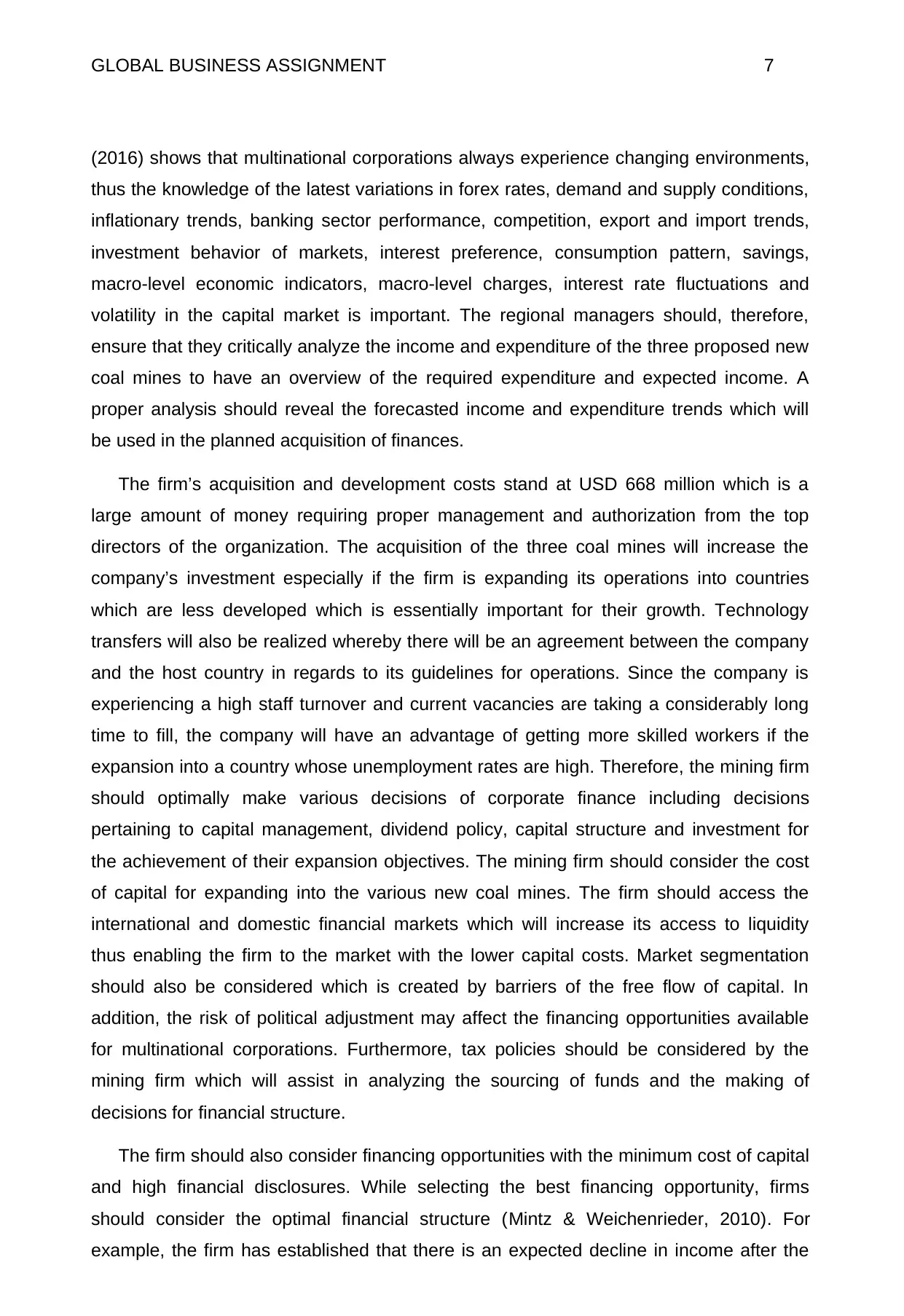
GLOBAL BUSINESS ASSIGNMENT 7
(2016) shows that multinational corporations always experience changing environments,
thus the knowledge of the latest variations in forex rates, demand and supply conditions,
inflationary trends, banking sector performance, competition, export and import trends,
investment behavior of markets, interest preference, consumption pattern, savings,
macro-level economic indicators, macro-level charges, interest rate fluctuations and
volatility in the capital market is important. The regional managers should, therefore,
ensure that they critically analyze the income and expenditure of the three proposed new
coal mines to have an overview of the required expenditure and expected income. A
proper analysis should reveal the forecasted income and expenditure trends which will
be used in the planned acquisition of finances.
The firm’s acquisition and development costs stand at USD 668 million which is a
large amount of money requiring proper management and authorization from the top
directors of the organization. The acquisition of the three coal mines will increase the
company’s investment especially if the firm is expanding its operations into countries
which are less developed which is essentially important for their growth. Technology
transfers will also be realized whereby there will be an agreement between the company
and the host country in regards to its guidelines for operations. Since the company is
experiencing a high staff turnover and current vacancies are taking a considerably long
time to fill, the company will have an advantage of getting more skilled workers if the
expansion into a country whose unemployment rates are high. Therefore, the mining firm
should optimally make various decisions of corporate finance including decisions
pertaining to capital management, dividend policy, capital structure and investment for
the achievement of their expansion objectives. The mining firm should consider the cost
of capital for expanding into the various new coal mines. The firm should access the
international and domestic financial markets which will increase its access to liquidity
thus enabling the firm to the market with the lower capital costs. Market segmentation
should also be considered which is created by barriers of the free flow of capital. In
addition, the risk of political adjustment may affect the financing opportunities available
for multinational corporations. Furthermore, tax policies should be considered by the
mining firm which will assist in analyzing the sourcing of funds and the making of
decisions for financial structure.
The firm should also consider financing opportunities with the minimum cost of capital
and high financial disclosures. While selecting the best financing opportunity, firms
should consider the optimal financial structure (Mintz & Weichenrieder, 2010). For
example, the firm has established that there is an expected decline in income after the
(2016) shows that multinational corporations always experience changing environments,
thus the knowledge of the latest variations in forex rates, demand and supply conditions,
inflationary trends, banking sector performance, competition, export and import trends,
investment behavior of markets, interest preference, consumption pattern, savings,
macro-level economic indicators, macro-level charges, interest rate fluctuations and
volatility in the capital market is important. The regional managers should, therefore,
ensure that they critically analyze the income and expenditure of the three proposed new
coal mines to have an overview of the required expenditure and expected income. A
proper analysis should reveal the forecasted income and expenditure trends which will
be used in the planned acquisition of finances.
The firm’s acquisition and development costs stand at USD 668 million which is a
large amount of money requiring proper management and authorization from the top
directors of the organization. The acquisition of the three coal mines will increase the
company’s investment especially if the firm is expanding its operations into countries
which are less developed which is essentially important for their growth. Technology
transfers will also be realized whereby there will be an agreement between the company
and the host country in regards to its guidelines for operations. Since the company is
experiencing a high staff turnover and current vacancies are taking a considerably long
time to fill, the company will have an advantage of getting more skilled workers if the
expansion into a country whose unemployment rates are high. Therefore, the mining firm
should optimally make various decisions of corporate finance including decisions
pertaining to capital management, dividend policy, capital structure and investment for
the achievement of their expansion objectives. The mining firm should consider the cost
of capital for expanding into the various new coal mines. The firm should access the
international and domestic financial markets which will increase its access to liquidity
thus enabling the firm to the market with the lower capital costs. Market segmentation
should also be considered which is created by barriers of the free flow of capital. In
addition, the risk of political adjustment may affect the financing opportunities available
for multinational corporations. Furthermore, tax policies should be considered by the
mining firm which will assist in analyzing the sourcing of funds and the making of
decisions for financial structure.
The firm should also consider financing opportunities with the minimum cost of capital
and high financial disclosures. While selecting the best financing opportunity, firms
should consider the optimal financial structure (Mintz & Weichenrieder, 2010). For
example, the firm has established that there is an expected decline in income after the
Paraphrase This Document
Need a fresh take? Get an instant paraphrase of this document with our AI Paraphraser
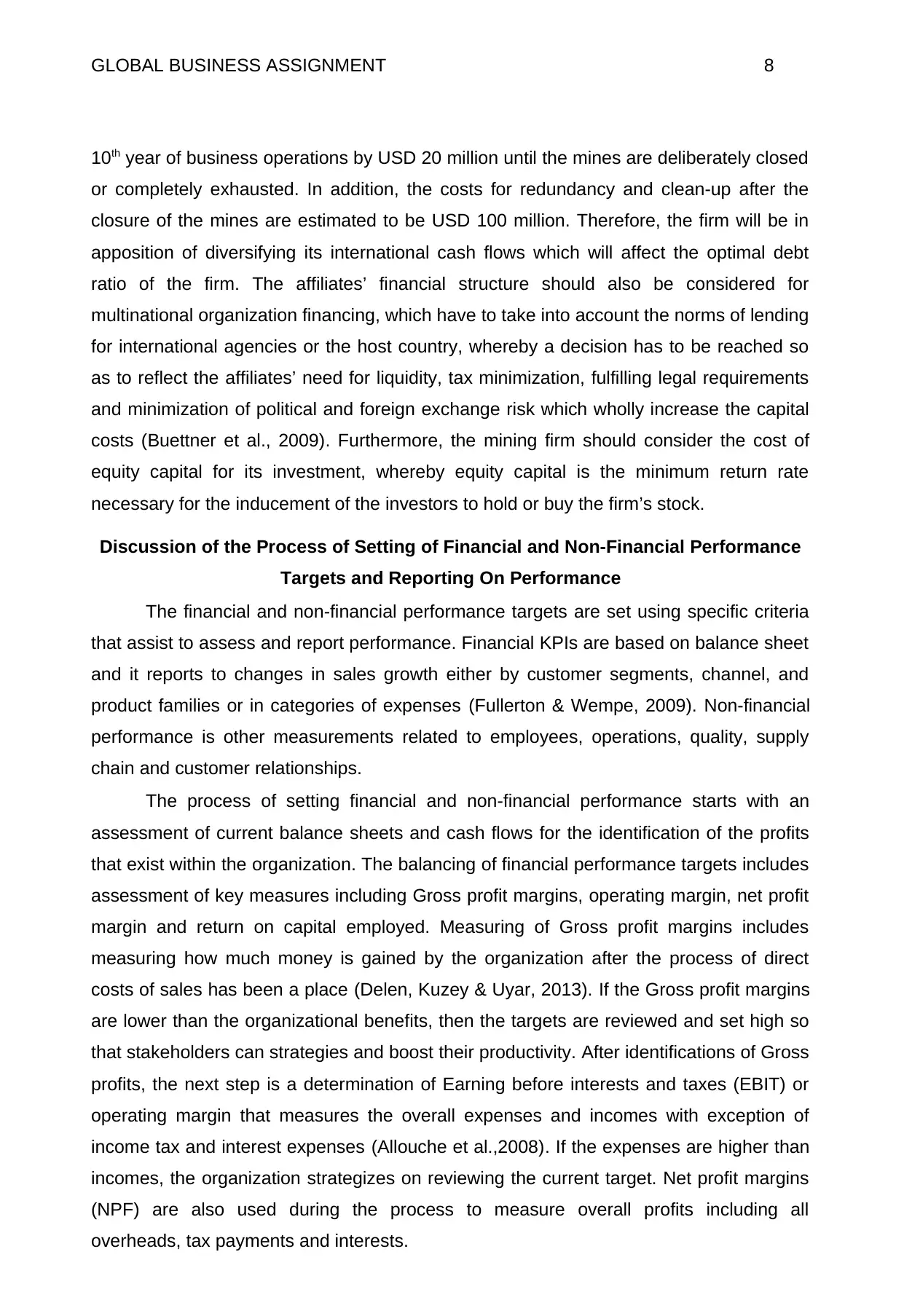
GLOBAL BUSINESS ASSIGNMENT 8
10th year of business operations by USD 20 million until the mines are deliberately closed
or completely exhausted. In addition, the costs for redundancy and clean-up after the
closure of the mines are estimated to be USD 100 million. Therefore, the firm will be in
apposition of diversifying its international cash flows which will affect the optimal debt
ratio of the firm. The affiliates’ financial structure should also be considered for
multinational organization financing, which have to take into account the norms of lending
for international agencies or the host country, whereby a decision has to be reached so
as to reflect the affiliates’ need for liquidity, tax minimization, fulfilling legal requirements
and minimization of political and foreign exchange risk which wholly increase the capital
costs (Buettner et al., 2009). Furthermore, the mining firm should consider the cost of
equity capital for its investment, whereby equity capital is the minimum return rate
necessary for the inducement of the investors to hold or buy the firm’s stock.
Discussion of the Process of Setting of Financial and Non-Financial Performance
Targets and Reporting On Performance
The financial and non-financial performance targets are set using specific criteria
that assist to assess and report performance. Financial KPIs are based on balance sheet
and it reports to changes in sales growth either by customer segments, channel, and
product families or in categories of expenses (Fullerton & Wempe, 2009). Non-financial
performance is other measurements related to employees, operations, quality, supply
chain and customer relationships.
The process of setting financial and non-financial performance starts with an
assessment of current balance sheets and cash flows for the identification of the profits
that exist within the organization. The balancing of financial performance targets includes
assessment of key measures including Gross profit margins, operating margin, net profit
margin and return on capital employed. Measuring of Gross profit margins includes
measuring how much money is gained by the organization after the process of direct
costs of sales has been a place (Delen, Kuzey & Uyar, 2013). If the Gross profit margins
are lower than the organizational benefits, then the targets are reviewed and set high so
that stakeholders can strategies and boost their productivity. After identifications of Gross
profits, the next step is a determination of Earning before interests and taxes (EBIT) or
operating margin that measures the overall expenses and incomes with exception of
income tax and interest expenses (Allouche et al.,2008). If the expenses are higher than
incomes, the organization strategizes on reviewing the current target. Net profit margins
(NPF) are also used during the process to measure overall profits including all
overheads, tax payments and interests.
10th year of business operations by USD 20 million until the mines are deliberately closed
or completely exhausted. In addition, the costs for redundancy and clean-up after the
closure of the mines are estimated to be USD 100 million. Therefore, the firm will be in
apposition of diversifying its international cash flows which will affect the optimal debt
ratio of the firm. The affiliates’ financial structure should also be considered for
multinational organization financing, which have to take into account the norms of lending
for international agencies or the host country, whereby a decision has to be reached so
as to reflect the affiliates’ need for liquidity, tax minimization, fulfilling legal requirements
and minimization of political and foreign exchange risk which wholly increase the capital
costs (Buettner et al., 2009). Furthermore, the mining firm should consider the cost of
equity capital for its investment, whereby equity capital is the minimum return rate
necessary for the inducement of the investors to hold or buy the firm’s stock.
Discussion of the Process of Setting of Financial and Non-Financial Performance
Targets and Reporting On Performance
The financial and non-financial performance targets are set using specific criteria
that assist to assess and report performance. Financial KPIs are based on balance sheet
and it reports to changes in sales growth either by customer segments, channel, and
product families or in categories of expenses (Fullerton & Wempe, 2009). Non-financial
performance is other measurements related to employees, operations, quality, supply
chain and customer relationships.
The process of setting financial and non-financial performance starts with an
assessment of current balance sheets and cash flows for the identification of the profits
that exist within the organization. The balancing of financial performance targets includes
assessment of key measures including Gross profit margins, operating margin, net profit
margin and return on capital employed. Measuring of Gross profit margins includes
measuring how much money is gained by the organization after the process of direct
costs of sales has been a place (Delen, Kuzey & Uyar, 2013). If the Gross profit margins
are lower than the organizational benefits, then the targets are reviewed and set high so
that stakeholders can strategies and boost their productivity. After identifications of Gross
profits, the next step is a determination of Earning before interests and taxes (EBIT) or
operating margin that measures the overall expenses and incomes with exception of
income tax and interest expenses (Allouche et al.,2008). If the expenses are higher than
incomes, the organization strategizes on reviewing the current target. Net profit margins
(NPF) are also used during the process to measure overall profits including all
overheads, tax payments and interests.
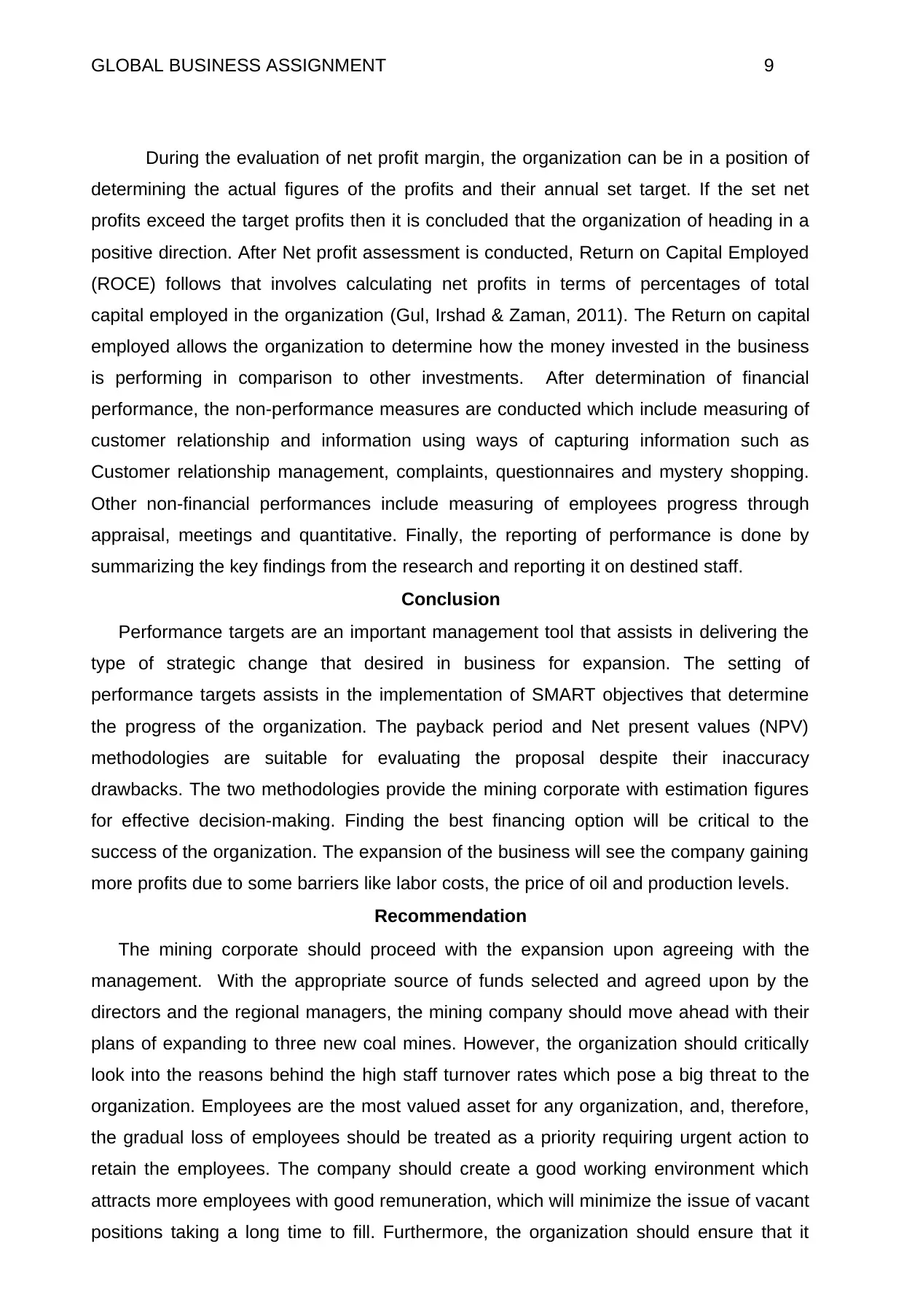
GLOBAL BUSINESS ASSIGNMENT 9
During the evaluation of net profit margin, the organization can be in a position of
determining the actual figures of the profits and their annual set target. If the set net
profits exceed the target profits then it is concluded that the organization of heading in a
positive direction. After Net profit assessment is conducted, Return on Capital Employed
(ROCE) follows that involves calculating net profits in terms of percentages of total
capital employed in the organization (Gul, Irshad & Zaman, 2011). The Return on capital
employed allows the organization to determine how the money invested in the business
is performing in comparison to other investments. After determination of financial
performance, the non-performance measures are conducted which include measuring of
customer relationship and information using ways of capturing information such as
Customer relationship management, complaints, questionnaires and mystery shopping.
Other non-financial performances include measuring of employees progress through
appraisal, meetings and quantitative. Finally, the reporting of performance is done by
summarizing the key findings from the research and reporting it on destined staff.
Conclusion
Performance targets are an important management tool that assists in delivering the
type of strategic change that desired in business for expansion. The setting of
performance targets assists in the implementation of SMART objectives that determine
the progress of the organization. The payback period and Net present values (NPV)
methodologies are suitable for evaluating the proposal despite their inaccuracy
drawbacks. The two methodologies provide the mining corporate with estimation figures
for effective decision-making. Finding the best financing option will be critical to the
success of the organization. The expansion of the business will see the company gaining
more profits due to some barriers like labor costs, the price of oil and production levels.
Recommendation
The mining corporate should proceed with the expansion upon agreeing with the
management. With the appropriate source of funds selected and agreed upon by the
directors and the regional managers, the mining company should move ahead with their
plans of expanding to three new coal mines. However, the organization should critically
look into the reasons behind the high staff turnover rates which pose a big threat to the
organization. Employees are the most valued asset for any organization, and, therefore,
the gradual loss of employees should be treated as a priority requiring urgent action to
retain the employees. The company should create a good working environment which
attracts more employees with good remuneration, which will minimize the issue of vacant
positions taking a long time to fill. Furthermore, the organization should ensure that it
During the evaluation of net profit margin, the organization can be in a position of
determining the actual figures of the profits and their annual set target. If the set net
profits exceed the target profits then it is concluded that the organization of heading in a
positive direction. After Net profit assessment is conducted, Return on Capital Employed
(ROCE) follows that involves calculating net profits in terms of percentages of total
capital employed in the organization (Gul, Irshad & Zaman, 2011). The Return on capital
employed allows the organization to determine how the money invested in the business
is performing in comparison to other investments. After determination of financial
performance, the non-performance measures are conducted which include measuring of
customer relationship and information using ways of capturing information such as
Customer relationship management, complaints, questionnaires and mystery shopping.
Other non-financial performances include measuring of employees progress through
appraisal, meetings and quantitative. Finally, the reporting of performance is done by
summarizing the key findings from the research and reporting it on destined staff.
Conclusion
Performance targets are an important management tool that assists in delivering the
type of strategic change that desired in business for expansion. The setting of
performance targets assists in the implementation of SMART objectives that determine
the progress of the organization. The payback period and Net present values (NPV)
methodologies are suitable for evaluating the proposal despite their inaccuracy
drawbacks. The two methodologies provide the mining corporate with estimation figures
for effective decision-making. Finding the best financing option will be critical to the
success of the organization. The expansion of the business will see the company gaining
more profits due to some barriers like labor costs, the price of oil and production levels.
Recommendation
The mining corporate should proceed with the expansion upon agreeing with the
management. With the appropriate source of funds selected and agreed upon by the
directors and the regional managers, the mining company should move ahead with their
plans of expanding to three new coal mines. However, the organization should critically
look into the reasons behind the high staff turnover rates which pose a big threat to the
organization. Employees are the most valued asset for any organization, and, therefore,
the gradual loss of employees should be treated as a priority requiring urgent action to
retain the employees. The company should create a good working environment which
attracts more employees with good remuneration, which will minimize the issue of vacant
positions taking a long time to fill. Furthermore, the organization should ensure that it
⊘ This is a preview!⊘
Do you want full access?
Subscribe today to unlock all pages.

Trusted by 1+ million students worldwide
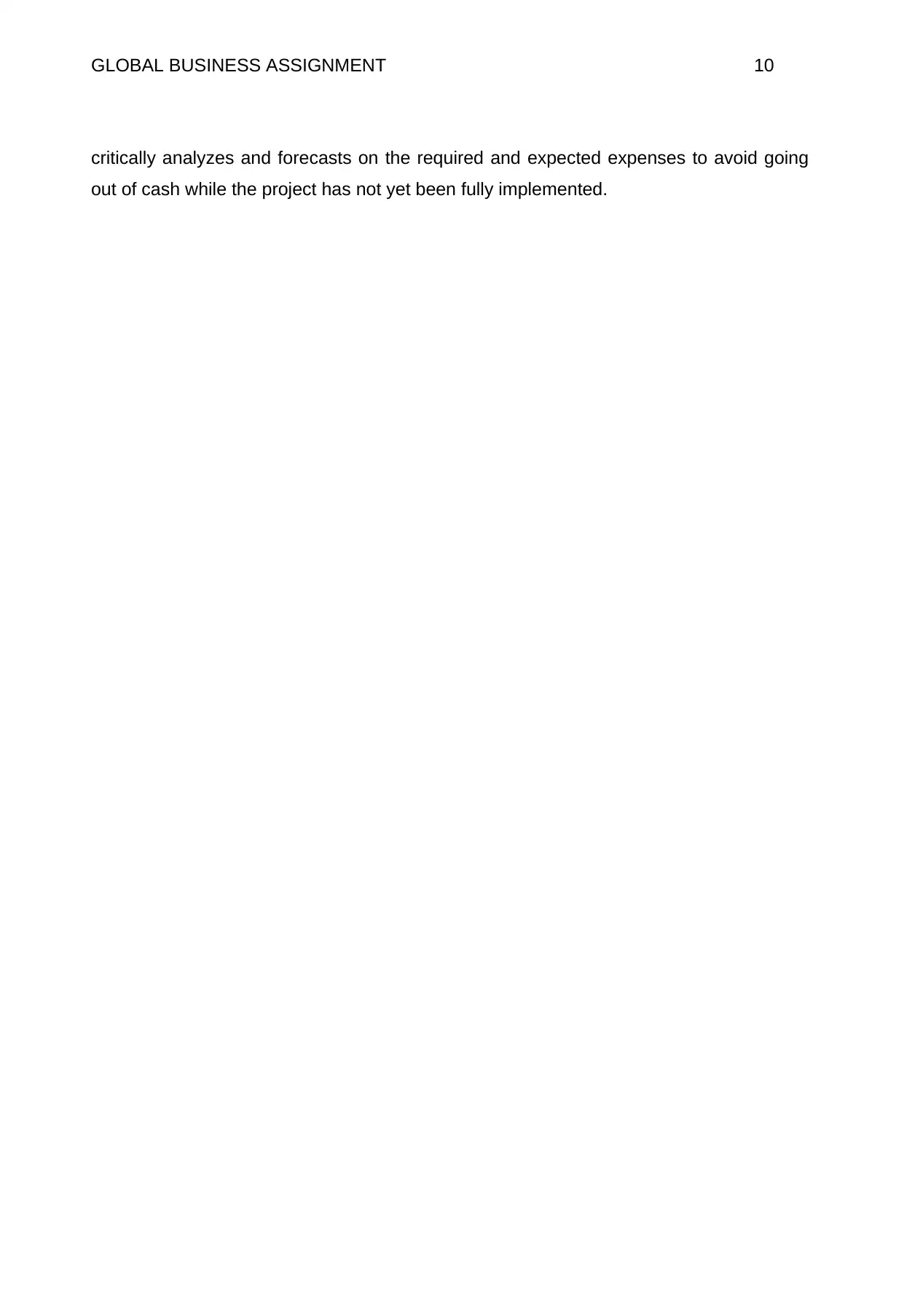
GLOBAL BUSINESS ASSIGNMENT 10
critically analyzes and forecasts on the required and expected expenses to avoid going
out of cash while the project has not yet been fully implemented.
critically analyzes and forecasts on the required and expected expenses to avoid going
out of cash while the project has not yet been fully implemented.
Paraphrase This Document
Need a fresh take? Get an instant paraphrase of this document with our AI Paraphraser
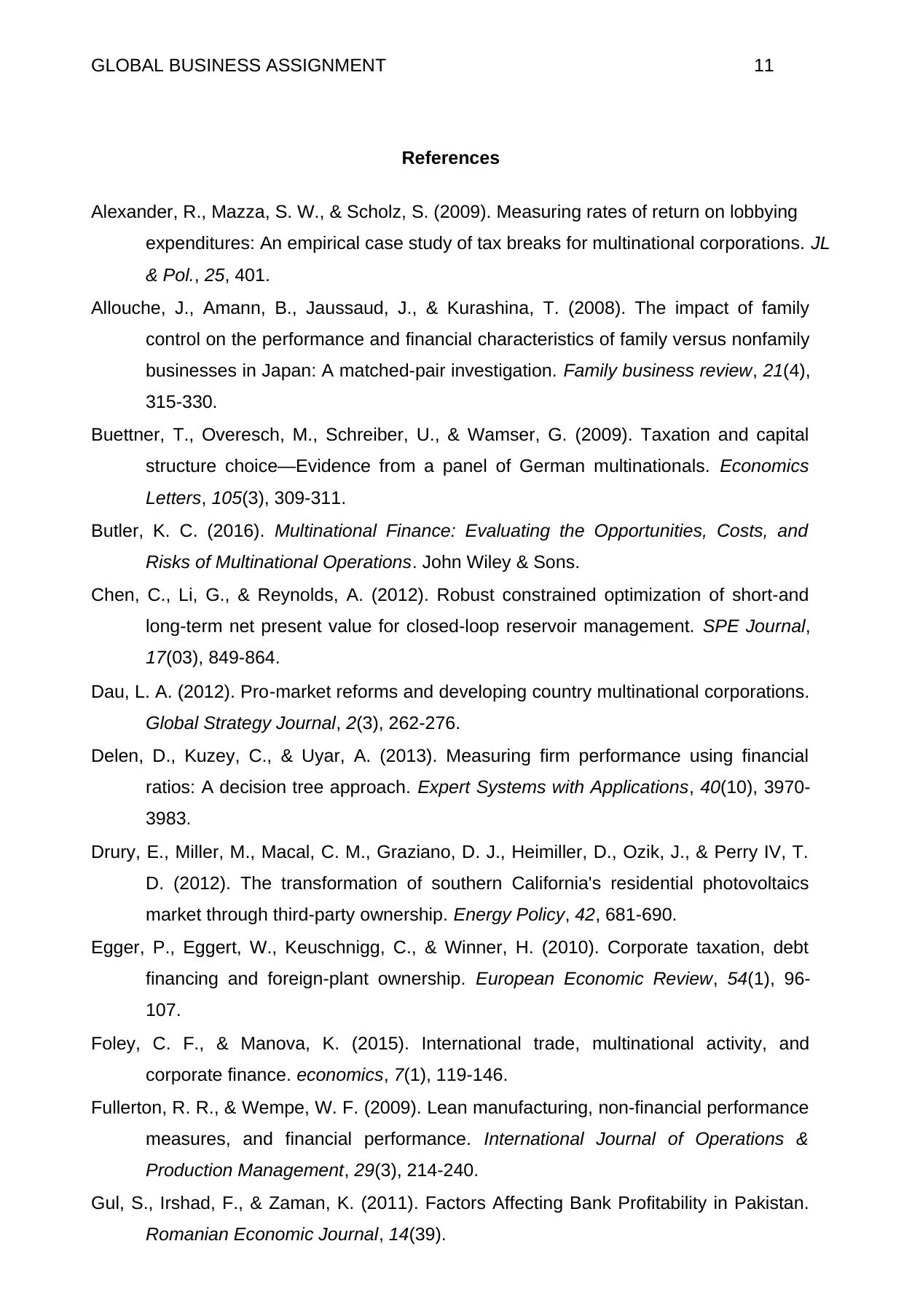
GLOBAL BUSINESS ASSIGNMENT 11
References
Alexander, R., Mazza, S. W., & Scholz, S. (2009). Measuring rates of return on lobbying
expenditures: An empirical case study of tax breaks for multinational corporations. JL
& Pol., 25, 401.
Allouche, J., Amann, B., Jaussaud, J., & Kurashina, T. (2008). The impact of family
control on the performance and financial characteristics of family versus nonfamily
businesses in Japan: A matched-pair investigation. Family business review, 21(4),
315-330.
Buettner, T., Overesch, M., Schreiber, U., & Wamser, G. (2009). Taxation and capital
structure choice—Evidence from a panel of German multinationals. Economics
Letters, 105(3), 309-311.
Butler, K. C. (2016). Multinational Finance: Evaluating the Opportunities, Costs, and
Risks of Multinational Operations. John Wiley & Sons.
Chen, C., Li, G., & Reynolds, A. (2012). Robust constrained optimization of short-and
long-term net present value for closed-loop reservoir management. SPE Journal,
17(03), 849-864.
Dau, L. A. (2012). Pro‐market reforms and developing country multinational corporations.
Global Strategy Journal, 2(3), 262-276.
Delen, D., Kuzey, C., & Uyar, A. (2013). Measuring firm performance using financial
ratios: A decision tree approach. Expert Systems with Applications, 40(10), 3970-
3983.
Drury, E., Miller, M., Macal, C. M., Graziano, D. J., Heimiller, D., Ozik, J., & Perry IV, T.
D. (2012). The transformation of southern California's residential photovoltaics
market through third-party ownership. Energy Policy, 42, 681-690.
Egger, P., Eggert, W., Keuschnigg, C., & Winner, H. (2010). Corporate taxation, debt
financing and foreign-plant ownership. European Economic Review, 54(1), 96-
107.
Foley, C. F., & Manova, K. (2015). International trade, multinational activity, and
corporate finance. economics, 7(1), 119-146.
Fullerton, R. R., & Wempe, W. F. (2009). Lean manufacturing, non-financial performance
measures, and financial performance. International Journal of Operations &
Production Management, 29(3), 214-240.
Gul, S., Irshad, F., & Zaman, K. (2011). Factors Affecting Bank Profitability in Pakistan.
Romanian Economic Journal, 14(39).
References
Alexander, R., Mazza, S. W., & Scholz, S. (2009). Measuring rates of return on lobbying
expenditures: An empirical case study of tax breaks for multinational corporations. JL
& Pol., 25, 401.
Allouche, J., Amann, B., Jaussaud, J., & Kurashina, T. (2008). The impact of family
control on the performance and financial characteristics of family versus nonfamily
businesses in Japan: A matched-pair investigation. Family business review, 21(4),
315-330.
Buettner, T., Overesch, M., Schreiber, U., & Wamser, G. (2009). Taxation and capital
structure choice—Evidence from a panel of German multinationals. Economics
Letters, 105(3), 309-311.
Butler, K. C. (2016). Multinational Finance: Evaluating the Opportunities, Costs, and
Risks of Multinational Operations. John Wiley & Sons.
Chen, C., Li, G., & Reynolds, A. (2012). Robust constrained optimization of short-and
long-term net present value for closed-loop reservoir management. SPE Journal,
17(03), 849-864.
Dau, L. A. (2012). Pro‐market reforms and developing country multinational corporations.
Global Strategy Journal, 2(3), 262-276.
Delen, D., Kuzey, C., & Uyar, A. (2013). Measuring firm performance using financial
ratios: A decision tree approach. Expert Systems with Applications, 40(10), 3970-
3983.
Drury, E., Miller, M., Macal, C. M., Graziano, D. J., Heimiller, D., Ozik, J., & Perry IV, T.
D. (2012). The transformation of southern California's residential photovoltaics
market through third-party ownership. Energy Policy, 42, 681-690.
Egger, P., Eggert, W., Keuschnigg, C., & Winner, H. (2010). Corporate taxation, debt
financing and foreign-plant ownership. European Economic Review, 54(1), 96-
107.
Foley, C. F., & Manova, K. (2015). International trade, multinational activity, and
corporate finance. economics, 7(1), 119-146.
Fullerton, R. R., & Wempe, W. F. (2009). Lean manufacturing, non-financial performance
measures, and financial performance. International Journal of Operations &
Production Management, 29(3), 214-240.
Gul, S., Irshad, F., & Zaman, K. (2011). Factors Affecting Bank Profitability in Pakistan.
Romanian Economic Journal, 14(39).
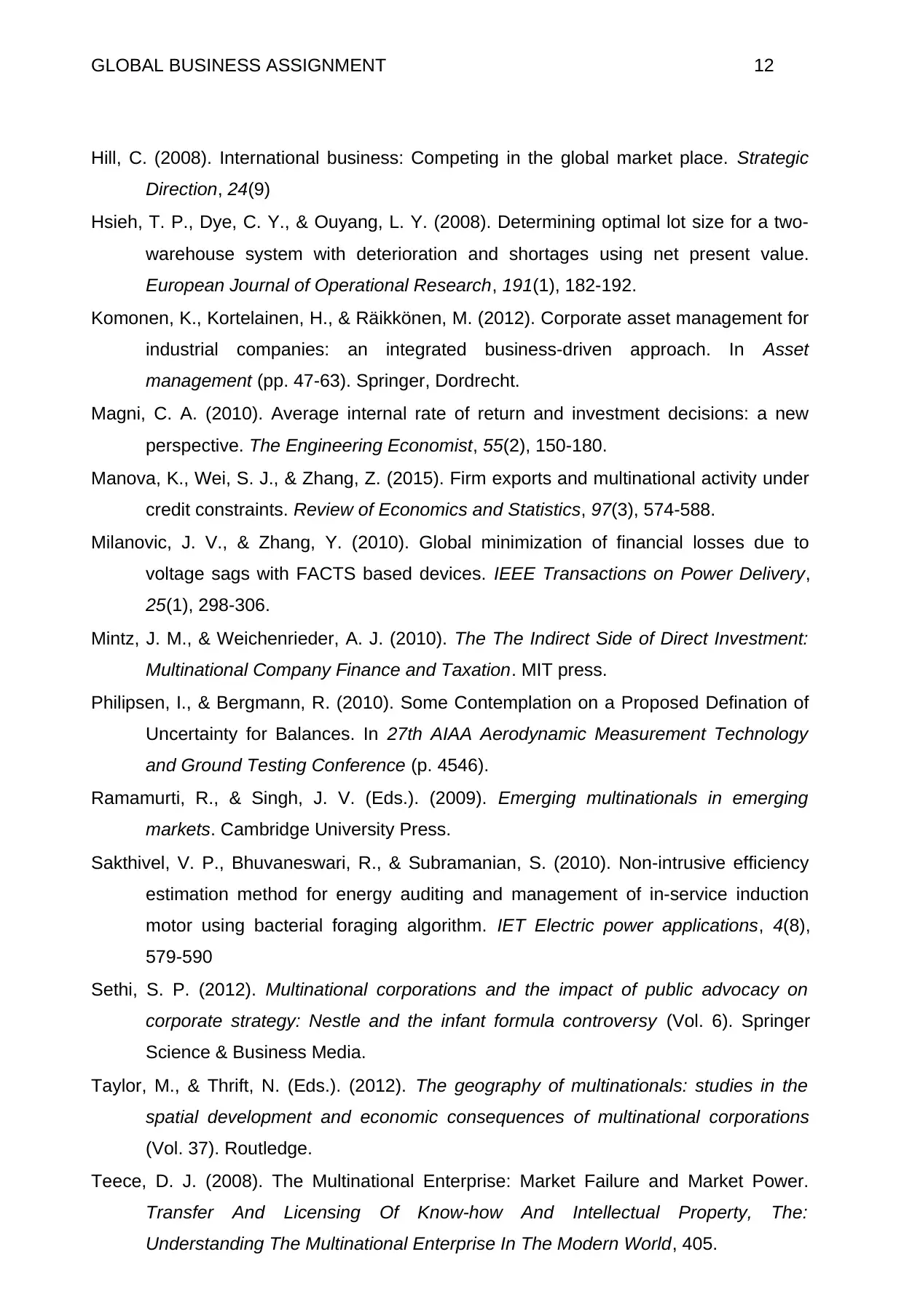
GLOBAL BUSINESS ASSIGNMENT 12
Hill, C. (2008). International business: Competing in the global market place. Strategic
Direction, 24(9)
Hsieh, T. P., Dye, C. Y., & Ouyang, L. Y. (2008). Determining optimal lot size for a two-
warehouse system with deterioration and shortages using net present value.
European Journal of Operational Research, 191(1), 182-192.
Komonen, K., Kortelainen, H., & Räikkönen, M. (2012). Corporate asset management for
industrial companies: an integrated business-driven approach. In Asset
management (pp. 47-63). Springer, Dordrecht.
Magni, C. A. (2010). Average internal rate of return and investment decisions: a new
perspective. The Engineering Economist, 55(2), 150-180.
Manova, K., Wei, S. J., & Zhang, Z. (2015). Firm exports and multinational activity under
credit constraints. Review of Economics and Statistics, 97(3), 574-588.
Milanovic, J. V., & Zhang, Y. (2010). Global minimization of financial losses due to
voltage sags with FACTS based devices. IEEE Transactions on Power Delivery,
25(1), 298-306.
Mintz, J. M., & Weichenrieder, A. J. (2010). The The Indirect Side of Direct Investment:
Multinational Company Finance and Taxation. MIT press.
Philipsen, I., & Bergmann, R. (2010). Some Contemplation on a Proposed Defination of
Uncertainty for Balances. In 27th AIAA Aerodynamic Measurement Technology
and Ground Testing Conference (p. 4546).
Ramamurti, R., & Singh, J. V. (Eds.). (2009). Emerging multinationals in emerging
markets. Cambridge University Press.
Sakthivel, V. P., Bhuvaneswari, R., & Subramanian, S. (2010). Non-intrusive efficiency
estimation method for energy auditing and management of in-service induction
motor using bacterial foraging algorithm. IET Electric power applications, 4(8),
579-590
Sethi, S. P. (2012). Multinational corporations and the impact of public advocacy on
corporate strategy: Nestle and the infant formula controversy (Vol. 6). Springer
Science & Business Media.
Taylor, M., & Thrift, N. (Eds.). (2012). The geography of multinationals: studies in the
spatial development and economic consequences of multinational corporations
(Vol. 37). Routledge.
Teece, D. J. (2008). The Multinational Enterprise: Market Failure and Market Power.
Transfer And Licensing Of Know-how And Intellectual Property, The:
Understanding The Multinational Enterprise In The Modern World, 405.
Hill, C. (2008). International business: Competing in the global market place. Strategic
Direction, 24(9)
Hsieh, T. P., Dye, C. Y., & Ouyang, L. Y. (2008). Determining optimal lot size for a two-
warehouse system with deterioration and shortages using net present value.
European Journal of Operational Research, 191(1), 182-192.
Komonen, K., Kortelainen, H., & Räikkönen, M. (2012). Corporate asset management for
industrial companies: an integrated business-driven approach. In Asset
management (pp. 47-63). Springer, Dordrecht.
Magni, C. A. (2010). Average internal rate of return and investment decisions: a new
perspective. The Engineering Economist, 55(2), 150-180.
Manova, K., Wei, S. J., & Zhang, Z. (2015). Firm exports and multinational activity under
credit constraints. Review of Economics and Statistics, 97(3), 574-588.
Milanovic, J. V., & Zhang, Y. (2010). Global minimization of financial losses due to
voltage sags with FACTS based devices. IEEE Transactions on Power Delivery,
25(1), 298-306.
Mintz, J. M., & Weichenrieder, A. J. (2010). The The Indirect Side of Direct Investment:
Multinational Company Finance and Taxation. MIT press.
Philipsen, I., & Bergmann, R. (2010). Some Contemplation on a Proposed Defination of
Uncertainty for Balances. In 27th AIAA Aerodynamic Measurement Technology
and Ground Testing Conference (p. 4546).
Ramamurti, R., & Singh, J. V. (Eds.). (2009). Emerging multinationals in emerging
markets. Cambridge University Press.
Sakthivel, V. P., Bhuvaneswari, R., & Subramanian, S. (2010). Non-intrusive efficiency
estimation method for energy auditing and management of in-service induction
motor using bacterial foraging algorithm. IET Electric power applications, 4(8),
579-590
Sethi, S. P. (2012). Multinational corporations and the impact of public advocacy on
corporate strategy: Nestle and the infant formula controversy (Vol. 6). Springer
Science & Business Media.
Taylor, M., & Thrift, N. (Eds.). (2012). The geography of multinationals: studies in the
spatial development and economic consequences of multinational corporations
(Vol. 37). Routledge.
Teece, D. J. (2008). The Multinational Enterprise: Market Failure and Market Power.
Transfer And Licensing Of Know-how And Intellectual Property, The:
Understanding The Multinational Enterprise In The Modern World, 405.
⊘ This is a preview!⊘
Do you want full access?
Subscribe today to unlock all pages.

Trusted by 1+ million students worldwide
1 out of 13
Related Documents
Your All-in-One AI-Powered Toolkit for Academic Success.
+13062052269
info@desklib.com
Available 24*7 on WhatsApp / Email
![[object Object]](/_next/static/media/star-bottom.7253800d.svg)
Unlock your academic potential
Copyright © 2020–2025 A2Z Services. All Rights Reserved. Developed and managed by ZUCOL.





